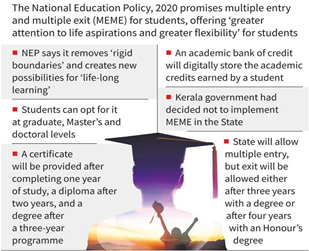

25th September 2023 (9 Topics)
Context
Recently, the Parliamentary Standing Committee on Education asks Central Government to hold discussions with all stakeholders on the issue of multiple entry and multiple exit (MEME) available for students in Higher education under the national education policy (NEP).
About the panel suggestion:
- The panel, in a report titled ‘Implementation of the National Education Policy, 2020 in Higher Education’, has mentioned that the Indian institutions were likely to face several issues in implementing MEME system.
- The report was tabled in both Houses of Parliament during the recently concluded special session.
- The Panel has asked the Centre to develop comprehensive guidelines and a well-defined framework for MEME options, including specific eligibility criteria, credit transfer mechanisms providing clear road map for students pursuing different exit points.
What is Multiple Entry and Multiple Exit (MEME)?
- The National Education Policy (NEP) suggests implementing a multiple entry and multiple exit (MEME) system in higher education.
- This system in education is a flexible approach that allows students to enter and exit academic programs at various points, rather than following a linear and fixed path.

Benefits:
- Flexibility: MEME offers students the flexibility to join an educational program at different stages.
- Modular Learning: Under MEME, academic programs are often broken down into modular units or courses. Students can choose to complete individual modules and accumulate credits over time.
- Exit Options: Students have the option to exit a program at various stages and receive a certificate or diploma based on the completed coursework.
- Re-entry: MEME also allows students who have exited to re-enter the program at a later time, picking up where they left off.
- Personalization: MEME recognizes that students have different learning paces and goals. It allows them to tailor their educational journey to their needs and aspirations.
- Reduced Pressure: The system reduces the pressure on students to complete an entire program in a fixed timeframe. It accommodates work, family, and other commitments.
- Skill Development: MEME can promote skill development and workforce readiness by enabling students to acquire specific skills and qualifications that are relevant to their chosen career path.
Concerns associated:
- High Student Intake: India has a large number of students enrolling in higher education each year.
- The panel points out that with the implementation of MEME, institutions may find it challenging to predict the number of students exiting and joining midway.
- This unpredictability can disrupt the pupil-teacher ratio, which is essential for effective teaching and learning.
- Traffic of Students: MEME allows students to enter and exit higher education programs at various points.
- However, in a high-population country like India, managing the flow of students in and out of institutions could be complex and may strain resources.
- Uneven geographical distribution of higher educational institutions would create hurdles in managing MEME in several areas, mostly countryside.
Suggestive measures
- The implementation of a standardised Credit Accumulation and Transfer (CAT) system can allow students to earn and transfer credits seamlessly across institutions would facilitate smooth transitions between different levels of education, from certificate courses to doctoral programmes.
- The panel recommended the Union Education Ministry to have wider consultations with various universities/institutions, their regulatory bodies and other stakeholders to devise ways in view of the difficulties being faced in implementing the MEME options and apprise the panel of it.
More Articles


